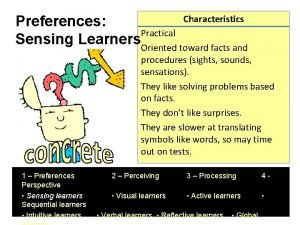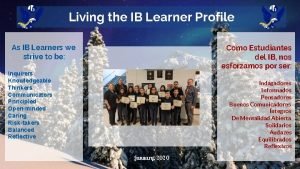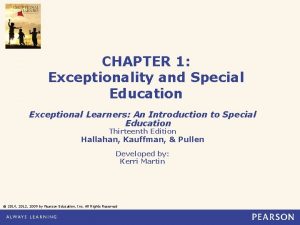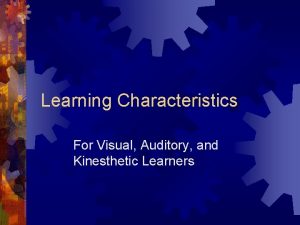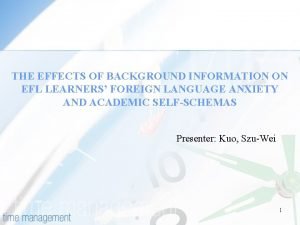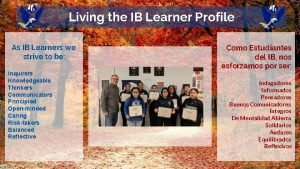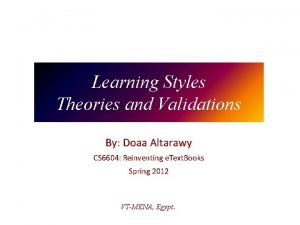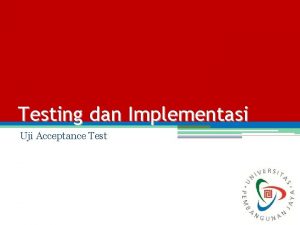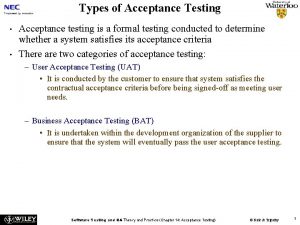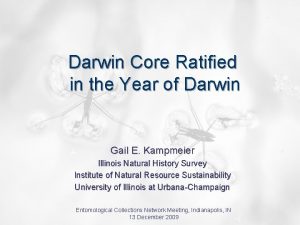Towards a Development of a Learners Ratified Acceptance
























- Slides: 24

Towards a Development of a Learners’ Ratified Acceptance of Multi-biometrics Intentions Model (RAMIM): Initial Empirical Results By: Yair Levy Nova Southeastern University and Michelle M. Ramim Nova Southeastern University 2009 - Dr. Yair Levy & Dr. Michelle Ramim – Chais 2009, Israel – February 18, 2009. 1

Outline • • • Introduction Statement of the problem Objective Theoretical background Proposed initial model and propositions Methodology and sample Data analysis and results Implications Proposed revised model 2009 - Dr. Yair Levy & Dr. Michelle Ramim – Chais 2009, Israel – February 18, 2009. 2

Introduction • • • Growing use of organizational electronic records Growing use e-learning Valid authentication of users is a perpetual challenge amongst organizations Authentication should expand beyond the limited username/password verification Reduce misuse and unethical conduct * Source: United States Department of Education, National Center of Educational Statistics (NCES) (2005) 2009 - Dr. Yair Levy & Dr. Michelle Ramim – Chais 2009, Israel – February 18, 2009. 3

Introduction (Cont. ) • The use of information security related devices in highly secured environments: – Financial institutions – Government agencies – Military facilities • Expanded utility for management – Employee attendance – Track employee daily activities 2009 - Dr. Yair Levy & Dr. Michelle Ramim – Chais 2009, Israel – February 18, 2009. 4

Statement of the problem • A growing concern – Invasiveness of biometric devices – Effective safeguarding of biometric information – Potential misuse of information captured by biometric devices – Increase of identity fraud crimes – Compromising of existing identification methodologies 2009 - Dr. Yair Levy & Dr. Michelle Ramim – Chais 2009, Israel – February 18, 2009. 5

Statement of the problem (Cont. ) • • • Context of e-learning systems Issues with academic misconduct A new trend • • • Integrate more than a single biometric method of authentication Increase accuracy Transparency Reliability beyond the initial point of entry Monitoring real-time users’ activity in a non-intrusive manner 2009 - Dr. Yair Levy & Dr. Michelle Ramim – Chais 2009, Israel – February 18, 2009. 6

Objectives • • Multi-biometric authentication method Initial empirical results Develop and validate a learners’ Ratified Acceptance of Multi-biometrics Intentions Model (RAMIM). The multi-biometric authentication – Two devices: fingerprint scanner and Web-cam head geometry scanner 2009 - Dr. Yair Levy & Dr. Michelle Ramim – Chais 2009, Israel – February 18, 2009. 7

Theoretical Background • Authentication Theory – Authentication is the process whereby the system verifies the user’s identity as declared (Liebl, 1993). – Two principal authentication elements: • • Identification - the user declares their identity Verification - the identity is validated – There are several established authentication protocols (password authentication protocol (PAP), encryption, etc. ) 2009 - Dr. Yair Levy & Dr. Michelle Ramim – Chais 2009, Israel – February 18, 2009. 8

Theoretical Background (Cont. ) • User authentication: (Furnell et al. , 2000) – – – • • • Something the user knows (e. g. password or personal identification number (PIN)) Something the user has (e. g. a card, token, etc) Something the user is (e. g. a biometric characteristic) Passwords are the most common authentication method (Oorschot & Thorpe, 2008; Rodwell, Furnell, & Reynolds, 2007) Passwords tend to be undermined by users Promote additional authentication methods – – Physiological and behavioral biometrics Multiple means of authentications 2009 - Dr. Yair Levy & Dr. Michelle Ramim – Chais 2009, Israel – February 18, 2009. 9

Theoretical Background (Cont. ) • Biometrics - a process that examines unique biological characteristics of humans (James et al. , 2006) – – – • DNA, voice, retinal and iris, fingerprints, facial images, hand prints, or other unique biological characteristics Biometric technologies operate by scanning a biological characteristic and matching it with the stored data Behavioral characteristics - keystrokes dynamics, and mouse clicks (Sasamoto et al. , 2008; Pusara & Brodley, 2004) Further work is needed to commercialize such methods to large scale systems. 2009 - Dr. Yair Levy & Dr. Michelle Ramim – Chais 2009, Israel – February 18, 2009. 10

Multi-Biometrics • A multilateral model scheme that utilizes a mixture of two or more biological and/or physiological characteristics that the end-user has in a secured environment • Multi-biometrics can enable ongoing nonintrusive verification not only at the point of entry but also throughout the logged-in session. • Use in various corporate and e-learning situations. • The context outlined here is during e-exams. 2009 - Dr. Yair Levy & Dr. Michelle Ramim – Chais 2009, Israel – February 18, 2009. 11

Users’ Acceptance of Technology • Challenges in experiments with biometrics • Before moving to experiments with actual systems, seek better understanding of the acceptance of such systems by the users (Venkatesh et al. , 2003) • Users’ perceived usefulness and ease-of-use are strong predictors of technology acceptance (Davis, 1989; Simon & Paper, 2007; Venkatesh et al. , 2003; Viswanath & Hillol, 2008). – Theory of Reasoned Action (TRA) (Ajzen & Fishbein, 1980). • Intention to use a technology is a significant predictor of actual use (Bagozzi, 2007; Gefen et al. , 2003) 2009 - Dr. Yair Levy & Dr. Michelle Ramim – Chais 2009, Israel – February 18, 2009. 12

Ethical Decision Making • Users’ ethical decisions making • Ethical issues with the use of e-learning systems have been a growing concern • Users who are more ethically driven will be open to accept multi-biometrics • Learners who are more ethically driven will be more inclined to use multi-biometrics during eexams. 2009 - Dr. Yair Levy & Dr. Michelle Ramim – Chais 2009, Israel – February 18, 2009. 13

Familiarity with Code of Conduct • Users’ familiarity with code of conduct (Chonko, 2003; Harris, 2002). • Users who are more familiar with the organization’s code of conduct will be open to accept security devices as they understand the need to maintain proper conduct (Wotruba et al. , 2001). 2009 - Dr. Yair Levy & Dr. Michelle Ramim – Chais 2009, Israel – February 18, 2009. 14

Proposed Initial Model 2009 - Dr. Yair Levy & Dr. Michelle Ramim – Chais 2009, Israel – February 18, 2009. 15

Propositions P 1: Learners’ familiarity with university’s code of conduct will have a significant positive contribution to their intention to use multi-biometrics for authentication during e-learning exams. P 2: Learners’ perceived ease-of-use will have a significant positive contribution to their intention to use multibiometrics for authentication during e-learning exams. P 3: Learners’ perceived usefulness will have a significant positive contribution to their intention to use multibiometrics for authentication during e-learning exams. P 4: Learners’ ethical decision making will have a significant positive contribution to their intention to use multibiometrics for authentication during e-learning exams. 2009 - Dr. Yair Levy & Dr. Michelle Ramim – Chais 2009, Israel – February 18, 2009. 16

Methodology • Use of validated measures from prior literature – Perceived ease-of-use, perceived usefulness, and intention to use were adopted (Gefen et al. , 2003; James et al. , 2006). – Familiarity with the code of conduct and ethical decision making (Ramim, 2007). • All items used 5 -point Likert-type scale. • Survey items were specifically in the context of intention to use multi-biometrics for authentication during e-learning exams. • Used Ordinal Logistic Regression (OLR) for initial data. Plan to use Structural Equations Modeling (SEM) in the future. 2009 - Dr. Yair Levy & Dr. Michelle Ramim – Chais 2009, Israel – February 18, 2009. 17

Sample • The sample: 97 entry level managers from service oriented organization and government agencies in USA who attended e-learning Masters of Business Administration (MBA) and Masters of Public Administration (MPA) courses. • Gender distribution: 61% males and 39% females • About 60% between the ages of 19 -34. • Majority (above 81%) had previously taken two or more e-learning courses 2009 - Dr. Yair Levy & Dr. Michelle Ramim – Chais 2009, Israel – February 18, 2009. 18

Data Analysis and Results Overall Ordinal Logistic Regression Model Fit (N= 97) Ordinal Logistic Regression Parameter Estimates Results (N= 97) 2009 - Dr. Yair Levy & Dr. Michelle Ramim – Chais 2009, Israel – February 18, 2009. 19

Data Analysis and Results (Cont. ) 2009 - Dr. Yair Levy & Dr. Michelle Ramim – Chais 2009, Israel – February 18, 2009. 20

Proposed Revised Model 2009 - Dr. Yair Levy & Dr. Michelle Ramim – Chais 2009, Israel – February 18, 2009. 21

Thank you! • Questions? 2009 - Dr. Yair Levy & Dr. Michelle Ramim – Chais 2009, Israel – February 18, 2009. 22

Contact Information - Michelle M. Ramim, Ph. D. Part-time Professor Nova Southeastern University H. Wayne Huizenga School of Business and Entrepreneurship The De. Santis Building 3301 College Avenue Ft. Lauderdale, FL 33314 E-mail: ramim@nova. edu Site: http: //www. nova. edu/~ramim/ 2009 - Dr. Yair Levy & Dr. Michelle Ramim – Chais 2009, Israel – February 18, 2009. 23

Contact Information - Yair Levy, Ph. D. Associate Professor Nova Southeastern University Graduate School of Computer and Information Sciences The De. Santis Building - Room 4058 3301 College Avenue Fort Lauderdale, FL 33314 Tel. : 954 -262 -2006 Fax: 954 -262 -3915 E-mail: levyy@nova. edu Site: http: //scis. nova. edu/~levyy/ 2009 - Dr. Yair Levy & Dr. Michelle Ramim – Chais 2009, Israel – February 18, 2009. 24
 When is cognitivism beneficial for learners
When is cognitivism beneficial for learners Global learners characteristics
Global learners characteristics Ib learner profile inquirer
Ib learner profile inquirer Teaching grammar for young learners
Teaching grammar for young learners Charles darwin naturalist intelligence
Charles darwin naturalist intelligence Exceptional learners: an introduction to special education
Exceptional learners: an introduction to special education Diversity of learners
Diversity of learners Teaching young learners english
Teaching young learners english Characteristics of auditory learners
Characteristics of auditory learners Background information for learners
Background information for learners What is global-analytic continuum
What is global-analytic continuum Changing results for young learners
Changing results for young learners Ib learners profile
Ib learners profile Tactile learner definition
Tactile learner definition The learners will be able to
The learners will be able to Audioize
Audioize Impulsive learners
Impulsive learners Reading strategies for english language learners
Reading strategies for english language learners Lazy learning vs eager learning
Lazy learning vs eager learning Quadrant d learners
Quadrant d learners Equal protection for english language learners
Equal protection for english language learners Resolution number 435 series of 1997
Resolution number 435 series of 1997 Technology for diverse learners
Technology for diverse learners English language learners
English language learners Remedial teaching definition
Remedial teaching definition

